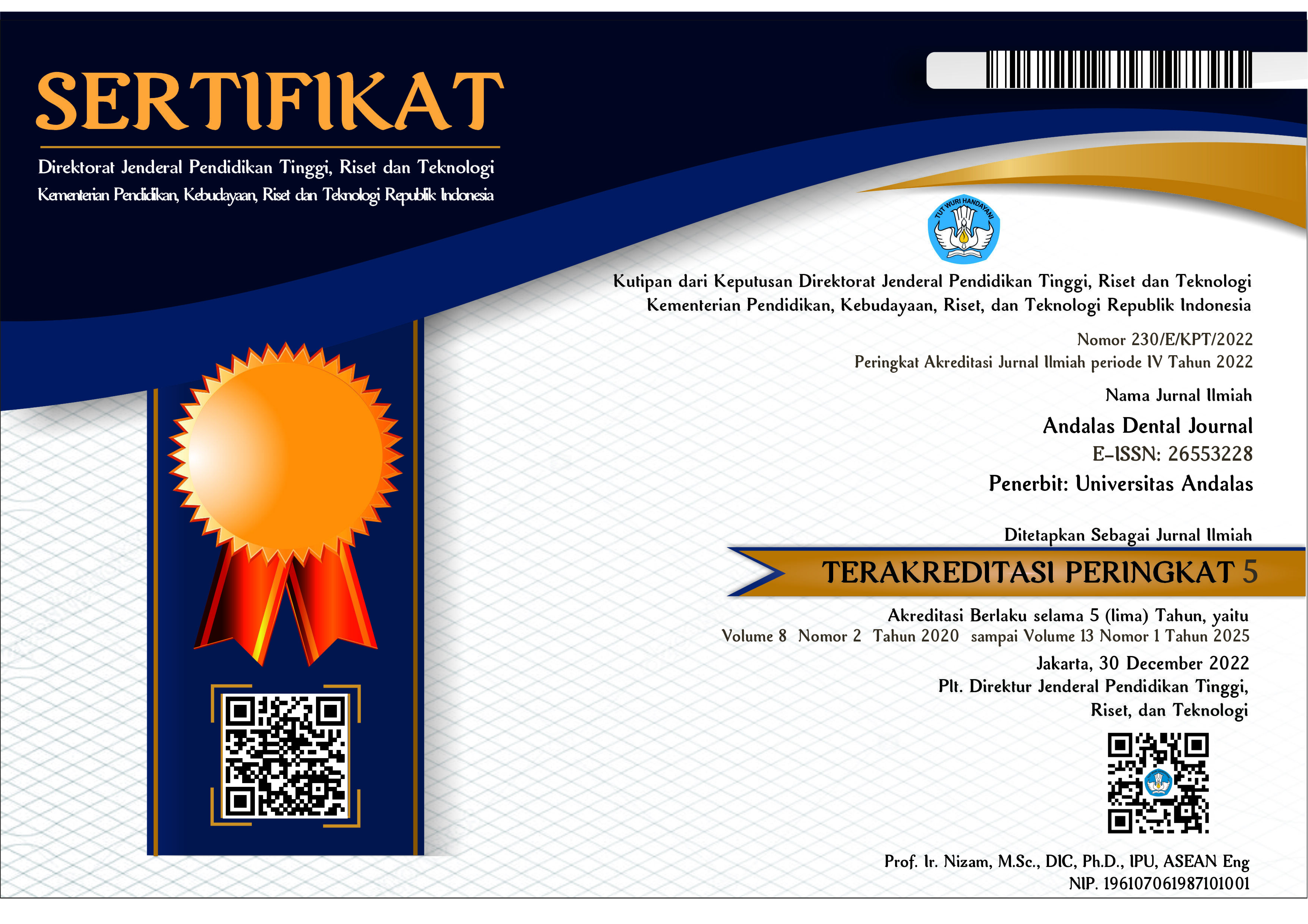Hubungan Status Gizi dengan Persistensi Gigi Sulung pada Anak Usia 13 –15 Tahun di Smpn 5 Padang
Abstract
Over-retained primary tooth is a condition of deciduous tooth that is retained beyond time of exfoliation, which should completely exfoliate at the end of the age of 12 years. This condition can cause delay in eruption of permanent tooth and thus lead to malocclusion and other orthodontic problems. One of the several reasons this condition happen is malnutrition. The purpose of this research is to determine the correlation between nutritional status and over-retained primary tooth among children aged 13 to 15 years at Junior High School 5 of Padang City. This research was an analytic observational study. The respondents were 95 students of Junior High School 5 of Padang. Respondents chosen with a Proportionate Stratified Random Sampling. This study determine that there are about 21,1% underweight respondents and 78,9% normal-overweight respondents. There are 45 retained primary teeth from 24 respondents. About 25,3% respondents had over-retained primary tooth with the highest prevalence occurred in maxilla with the mostly retained teeth was left canine (20%). From the Chi-Square test obtained p value = 1 is greater than the value that is meaningful probability (>0,05) which means there is no a significant correlation between nutritional status and over-retained primary tooth among children aged 13 to 15 years. The conclusion is there is no a significant value correlation between nutritional status and over-retained primary tooth among children aged 13 to 15 years.
References
2. Phinney DJ, Halstead JH. Delmar’s Dental Assisting: A Comprehensive Approach 2nd Edition. New York: Delmar Learning; 2004. pp. 108-10.
3. Gomella LG, Haist, SA. Clinician’s Pocket Reference. U.S: McGraw-Hill Professional; 2003. p. 13.
4. Siagian EY. Beberapa Anomali yang Disebabkan Persistensi Gigi serta Perawatannya. Medan: USU e- Repository; 2008. pp. 1-12.
5. Dale G. Guidance of Occlusion: Serial Extraction. Orthodontics Current Principles and Technique. St. Louis: C. V. Mosby Company; 1985. pp. 284-95.
6. Jahanimoghadam F. Case Report: Simultaneous Presence of Primary and Permanent Teeth. University of Medical Sciences of Kerman, Iran. 2015; 12:145- 7.
7. Fujita H. Prolonged Retention of Primary Teeth and TMD from the Archaeological Sample in the Edo Japanese. Eur J Prev Med. 2014; 2:110-3.
8. Jose A, Joseph MR. Prevalence of dental health problems among school going children in rural Kerala. J Indian Soc of Pedod Prev Dent. 2003; 21:147-51.
9. Badan Penelitian dan Pengembangan Kesehatan. Laporan Hasil Riset Kesehatan Dasar Nasional. Departemen Kesehatan Republik Indonesia; 2013. pp. 110,216.
10. Lestari ZD, Wibowo TB, Pradopo S. The Prevalence of Overretained Primary Teeth and Malocclusion in 6-12 Years Old Children. Indo Pediatr Dent J. 2010; 2:2-9.
11. Dinas Kesehatan Kota Padang. Laporan Tahunan Data K00 : Gangguan Perkembangan, Erupsi Gigi dan Persistensi. 2015.
12. Robinson S, Chan MF. New teeth from old: treatment options for retained primary teeth. Br Dent J. 2009; 20:315- 20.
13. Alvarez JO, Lewis CA, Saman C, Caceda J, Montalvo J, Figueroa ML, et al. Chronic malnutrition, dental caries, and tooth exfoliation in Peruvian children aged 3-9 years. Am J Clin Nutr.1988; 48:368-72.
14. UNICEF (United Nations Children’s Fund) Organization. Nutrition in Emergencies. 2009.
15. WHO (World Health Organization). World Health Statistics in 2012. 2012.
16. Dinas Kesehatan Kota Padang. Rekapitulasi Hasil Penjaringan Kesehatan Murid SMP/MTs Kota Padang. 2015.
17. Alvarez JO, Eguren JC, Caceda J, Navia JM. The Effect of Nutritional Status on the Age Distribution of Dental Caries in the Primary Teeth. J Dent Res. 1990; 69:1564-6.
18. Braver JC, Highley LB, Lindahl R, Massler M, Schour I. Dentistry For Children 4th Ed. New York: McGraw Hillbook Company; 1959. pp. 63,72.
19. Ikatan Dokter Anak Indonesia (IDAI). Seputar Kesehatan Anak: Nutrisi Pada Remaja Indonesia. 20
20. Polder BJ, Hof MA, Linden FP, Jagtman AM. A Metaanalysis of The Prevalence of Dental Agenesis of Permanent Teeth. Community Dent Oral Epidemiol. 2004; 32:217-26.
21. Stewar RE, Barber TK, Troutman KC, Wei SHY. Pediatric Dentistry: Scientific Foundation and Clinical Practice. St Louis: Mosby Elsevier; 1982. p. 276-7.
22. Dayal PK, Shodan KH, Bihani VK. Prolonged Retention of Multiple Primary Teeth. J Dent Child. 1982; 49:145-6.
23. Ireland R. Advance Dental Nursing. UK: Blackwell Munksguard Publishing Company; 2004. pp. 65-74.
24. Machfoedz I. Menjaga Kesehatan Gigi dan Mulut Anak-anak dan Ibu Hamil. Jakarta: Rajawali Pers; 2008. pp. 40-5.
25. Haeriyah. Tingkat Kepedulian Orang Tua Terhadap Pemeliharaan Kesehatan Gigi dan Mulut Anak Usia 6-36 Bulan di Kelurahan Tamalanrea Makasar. Makassar: Fakultas Kedokteran Gigi Universitas Hasanudin. 2013. pp. 2-7.















